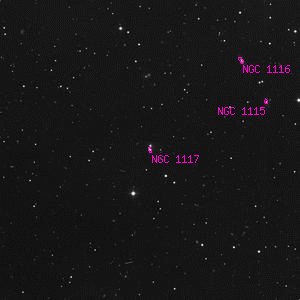NGC 1117

Overlaid DSS image of NGC 1117, 30' x 30' with north at top and west to the right
Aladin viewer for the region around NGC 1117
GC 5285, IC 1855, MCG +02-08-019, PGC 10822
| Type | Galaxy |
|---|---|
| Magnitude | 15 |
| Size | 0.5' x 0.3' @ 30° |
| Right Ascension | 2h 51' 13.1" (2000) |
| Declination | 13° 11' 7" N |
| Constellation | Aries |
| Description | close to a S* |
| Classification | E-SO |
Observing Notes
Harold Corwin
There is nothing in Javelle's nominal position, claimed to be -52.53 seconds of time, and +4' 54.2" from BD +12 393. The object I chose decades ago is a galaxy with a much brighter star to the south, and does not match Javelle's description: "Faint, double, the two components are in the position angle 0°; the nuclei are 15th magnitude. It is one arcminute in extent; the measurement refers to a point between the two objects."
This is a fair description of NGC 1117 (which see, with its own problems). But there are no stars at the offsets given by Javelle. There is, however, a curious coincidence with the declination: IF Javelle misidentified his comparison star (BD +12 394 rather than BD +12 393), and IF his north polar distance offset has the wrong sign, it matches the declination of NGC 1117. However, the RA offset does not match, even with switched signs (+60.9 seconds of time from the star).
Javelle has a footnote attached to his observation: "Also measured were NGC 1115 and NGC 1116". This lends some additional credence to the idea that the correct object is NGC 1117. But if so, the offsets refer to some star -- and perhaps even some other object -- that is not clearly identifiable.
In any case, the previous object I chose is simply an arbitrary one plucked off the sky for lack of anything better. We can just ignore it for now as it is clearly not Javelle's double nebula.
Harold Corwin
NGC 1117 may also be IC 1855 (which see; also see NGC 1109).
There is a double galaxy just 30 seconds of time east of Marth's position; this is probably his object. However, his only description is "close to a small *". Unfortunately, he does not tell us the direction of the "small *", so we do not know which of the galaxies is the one that he saw. Neither is obviously stellar on the sky survey plates/images, and the faint star near the southern galaxy is probably beyond his limit, even with a 48-inch telescope.
So, I've listed both objects with colons. This is a candidate for visual inspection: Does one galaxy appear more obviously stellar than the other?
Courtney Seligman
Albert Marth observed eight nebulae, subsequently listed as NGC 1109, NGC 1111, NGC 1112, NGC 1113, NGC 1115, NGC 1116, NGC 1117 and NGC 1127, on a single night in 1863. Of those, only three have positions that seem to more or less reliably correspond to actual objects -- NGC 1115, NGC 1116 and NGC 1127. NGC 1117 can be fit to a nearby galaxy, but its identification is far less certain, and NGC 1113 cannot be convincingly connected to any object. Still, that is not as complicated as the situation for NGC 1109, NGC 1111 and NGC 1112, each of which has two or more candidates for what Marth might have observed, and for several of those candidates, more than one suggestion as to which of Marth's objects a given candidate might correspond to; so for those NGC entries there is little if any hope that there will ever be a convincing argument for which objects correspond to which entries.
Other Data Sources for NGC 1117
Nearby objects for NGC 1117
12 objects found within 60'
| IC 1846 | IC 1850 | IC 1852 |
| IC 267 | NGC 1109 | NGC 1111 |
| NGC 1112 | NGC 1113 | NGC 1115 |
| NGC 1116 | NGC 1127 | NGC 1134 |
Credits...
Drawings, descriptions, and CCD photos are copyright Andrew Cooper unless otherwise noted, no usage without permission.
A complete list of credits and sources can be found on the about page
NGC 1117